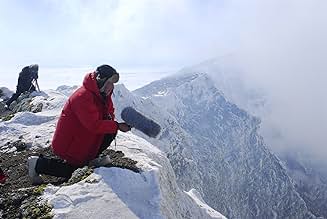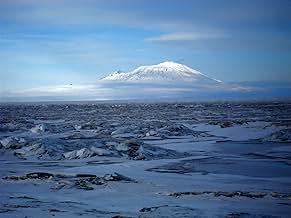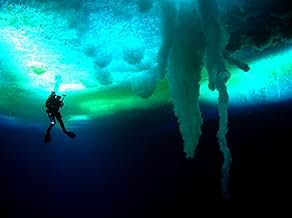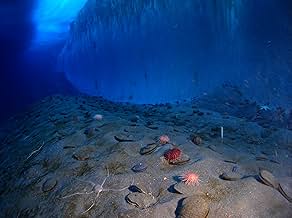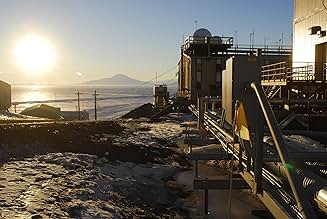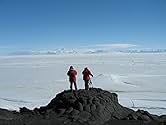Der Filmemacher Werner Herzog reist zur McMurdo-Station in der Antarktis, wo er der Schönheit des Kontinents und den dort lebenden Menschen ein filmisches Denkmal setzt.Der Filmemacher Werner Herzog reist zur McMurdo-Station in der Antarktis, wo er der Schönheit des Kontinents und den dort lebenden Menschen ein filmisches Denkmal setzt.Der Filmemacher Werner Herzog reist zur McMurdo-Station in der Antarktis, wo er der Schönheit des Kontinents und den dort lebenden Menschen ein filmisches Denkmal setzt.
- Für 1 Oscar nominiert
- 2 Gewinne & 16 Nominierungen insgesamt
- Self - Glaciologist
- (as Douglas MacAyeal)
- Self - Filmmaker, Cook
- (as Ryan A. Evans)
Empfohlene Bewertungen
The film perfectly balances both gorgeous footage of the continent as well as fascinating interviews and anecdotes of the many researchers and workers of the McMurdo research station. There are many humorous moments, such as a scene in which visitors must go through a follow-the-leader type exercise before being allowed to venture out into the wild. Participants in the exercise must wear buckets adorned with ridiculous caricatures over their heads in order to simulate a whiteout. They must then try to follow each other as a group and find a researcher a distance away. Herzog simply observes as the participants fail over and over to find the researcher, which left the audience laughing for minutes on end. Another excellent scene has Herzog interviewing an expert on penguins, who goes into some of their more bizarre behavior, such when penguins go insane. In both cases, Herzog features striking footage and amusing interviews and narration.
The film fits in well with Herzog's already substantial canon. It is a beautiful look at a beautiful continent populated by a forklift driver with a PhD, a woman who once traveled to South America in a sewage pipe on the back of a truck, researchers who play electric guitars on top of research station to celebrate discovering three new species of aquatic life in one day, and many more. Their stories converge where all the lines on the map meet at the end of the world. Herzog shot the film with a crew of just himself and the camera operator, and the result is a film with some of the most beautiful footage I've ever seen. Do not miss this when it receives general release!
But, the film STILL is mesmerizing. You learn about the very unearthly sort of sounds the seals make under the ice, the sad story of a mixed-up penguin, some amazing volcano research and lots of odd facts about this MOSTLY desolate continent. Well worth seeing--just don't be too turned off by the occasionally bizarre dialog.
My complaints are essentially twofold. First, the movie is disjointed. It is a hodgepodge of Herzog's encounters with various Antarctic researchers and residents; there is no apparent order or theme. This is a minor criticism, as most of the segments make for fine viewing on their own, but it would have been more satisfying if Herzog had presented a unifying thesis or two about the Light Continent (aside from the oft-repeated observation that it is populated by a fair number of "professional dreamers"). He should have at least arranged the segments in a clearly meaningful sequence. At its best, the film made no more of an impression on me than "that was beautiful," "that was cool," or "I didn't know that." Second, and more significantly, Herzog's narration is at times irritating. As someone who has studied climate change, I share his frustration and pessimism. But there is no call for saddling the film's final moments with apocalyptic platitudes (e.g., "the end of human life is assured") and a cursory reference to global warming. These sentiments are incongruous with the rest of the film, which does not substantially address environmentalism and whose most haunting scene is of a mad penguin that abandons its flock and runs inland towards distant mountains, to certain death, with a singular determination. Herzog's doomsayings, in any event, are better communicated by the satellite images of rapidly melting polar ice that we observe on a climatologist's computer screen. I know that Herzog is capable of more measured reflections on the impersonal and uncontrollable power of nature; for example, from Grizzly Man: "what haunts me is that in all the faces of all the bears that Treadwell ever filmed, I discover no kinship, no understanding, no mercy. I see only the overwhelming indifference of nature. To me, there is no such thing as a secret world of the bears. And this blank stare speaks only of a half-bored interest in food. But for Timothy Treadwell, this bear was a friend, a savior." In Encounters, Herzog superficially and self-indulgently overstates his case. I'm looking forward to his next film.
"There is no point that is south of the south pole." That's a no brainer, but have you ever thought about that before reading that statement? Such a simple and obvious saying, yet there's something quite poignant buried within it. It's pointed out by one of Werner Herzog's dreamers - a philosopher and part time forklift driver - that he found on his encounters at the end of the world.
Herzog begins his new documentary warning us that this will not be another film about fluffy penguins; his questions about nature are far different. For example, why does a sophisticated creature like a chimp not make use of inferior creatures - they could saddle goats and ride off into the sunset. Herzog delivers with a pondering and quizzical film. Encounters at the End of the World is about the intricacies - and insanities - of life on Antarctica. His visit was spurred on by the footage taken by one of the under-ice divers, a friend of his. He opens the film with the images of what appears to be hauntingly blue skies and bubbly white clouds, but its not skies nor clouds, but the clear waters and hulking ice. Herzog, always fascinated with the oddity and great beauty of the natural world, fills his documentary with stunning images and sequences. Underwater divers film strange creatures under the ice, and massive ice formations while navigating their way back to the single hole in the ice, without tether lines to guide them. Volcanologists traverse dormant lava tubes, only having to be weary of poison gases that can be found in some.
Herzog's base of operations is McMurdo, the largest settlement on the continent. He describes it as an ugly mining town. And it is ugly. It's filled with scientists, wanderers, adventurers and dreamers, all looking to 'jump off the margins of the map,' as one observer puts it. It also has "abominations" such as aerobics and yoga studios, even an ATM. Before he go in the field, he, like everyone else, must attend survival school, where among other things students learn to build shelter, and then must spend the night in it. They also partake in a white out simulation, achieved by wearing white buckets on their heads. They wander out to find the instructor, playing a lost peer. As they get disorientated, the scene becomes comical, but also points out our inferiority when up against nature.
Herzog does make a stop to visit some penguins briefly, and the man who studies them - reportedly no longer much of a conversationist with humans since he spends so much time isolated with penguins. Herzog's questions are amusing, but thoughtful. "Are there gay penguins?" "Is there such thing as madness among penguins?" The answer to that last question leads to one of the films most memorable and profound sequences.
The film at once is an admiration of those who find themselves working at the end of the world, and an admonition of the manipulation of adventure. Herzog wastes no time on the uninteresting people there. He talks with a scientist who describes a horrifying world that would tear us apart - if it were not too small to be seen by the human eye. He also shows old science fiction movies and warns of our fate. Some of them gather during the night, still day lit, for a jam session on top of their hut.Another woman discusses how she rode through South America in a sewer pipe, then zips herself into a travel bag. Another man, a plumber, says his hands prove that he is descended from Aztec and Inca royalty. On the other hand, he admonishes the notion of adventure for conquer. Shackleton came not for the sake of adventure, but to claim the South Pole. He almost lampoons some of his subjects, but is never disrespectful and clearly admires all of them.
The name of the film is something of a double entendre. Herzog frequently ponders another life after humans are gone. What would they think of us when they come see what we're doing in Antarctica? There are references to global warming and threats to our planet, but Herzog is no issue of the day crusader. So many other documentaries would condescend to us, and have. Green has become the fad of the day, annoying many instead of enlightening. Herzog is too much of an enigma to pander or preach to us, and that's part of the reason why Encounters at the End of the World is so special.
Werner Herzog is a man incapable of making a dull film. What is entirely true in this documentary is questionable as it is in his others. His pursuit of ecstatic truth - semi-fictions to capture the essence of what is more truthful than truth - gives him license to embellish. But no matter, if he has some of his interviewees script some details, I do no care to know which. I'm happy being mesmerized by the stories they tell as is.
For me, a Werner Herzog film is like pulling on a warm pair of slippers on a cold winter day, and pulling up by the fire to read a favorite book. Herzog was one of the first filmmakers to draw me into the world of great film-making, and for that I forever owe him a great debt of gratitude. And it was Roger Ebert who lead me to him, so how fitting that this beautiful film was dedicated to him.
This is not Shackleton's Antarctica. The main US base is more like a mining colony anywhere on the fringes of civilization then what you think of when you think Antarctica. Its strangely modern and looks to be almost anywhere people mine. Indeed there is an odd shot of the modern camp with Scott's hut in the distance that signals how times have changed.
Herzog's film is really about some of the wayward travelers who have reached the frontier. Herzog is curious what sort of people they are and finds them to be a rather philosophical lot. They are what you would consider explorers of the 18th or 19th century looking for something greater then themselves. As one guy says "Where else do you find guys with Phds doing the dishes, or linguists on the one place on earth where there is no native language." Its an amusing portrait of people I think many of us would like to be.
We also get a portrait of what life is like there. Of the eternal sun (which annoys Herzog)Of the drabness of the living quarters (motel like)mixed with individual expression. We see the survival training, the various scientific studies going on (including one about penguins which cause Herzog to ponder if they go mad). and we see the landscape both above and below the ice on land and in the sea. These portraits of the land and seascapes are stunning. Herzog's ability to mix music and image creates some hypnotic passages that in part reminded me Koyaanisqatsi or Luc Besson's Atlantis. Its magical and creates sequences that you hate to see end.
If there is any flaw is that the film kind of just ends. There is a wonderful final quote by Alan Watts, but the film ultimately feels like a philosophical travelogue about a summer vacation instead of something grander then what I saw on my vacation. I'm sure had it not been Werner Herzog behind the camera I would not have been disappointed.
Still you must see the film on a big screen if you can. Its really beautiful at times. It will enlighten and inspire you- much more than this review will. And even though this is a Discovery Channel film, I'm glad I saw it where I did because there is something about the end credits with the seal songs echoing all thorough the theater from front to back that you can't get at home. The long confines of the Film Forum in New York really allows for the magic of a sound scape.
7.5 out of 10
Wusstest du schon
- WissenswertesWerner Herzog dedicated the film to Roger Ebert, who he calls a true "warrior of cinema". Due to the dedication Ebert could not review the film, but he wrote a complimentary letter to Herzog and later published it.
- Zitate
[last lines]
Stefan Pashov: There is a beautiful saying by an American philosopher, Alan Watts. He used to say that through our eyes the universe is perceiving itself, and through our ears the universe is listening to its cosmic harmonies. And we are the witness to which the universe becomes conscious of its glory, of its magnificence.
- VerbindungenEdited from Formicula (1954)
- SoundtracksPlanino Stara Planino Mari
Written by Stefan Dragostinov
Performed by The Philip Koutev National Folk Ensemble
Top-Auswahl
- How long is Encounters at the End of the World?Powered by Alexa
Details
- Erscheinungsdatum
- Herkunftsland
- Offizieller Standort
- Sprachen
- Auch bekannt als
- Encounters at the End of the World
- Drehorte
- Produktionsfirmen
- Weitere beteiligte Unternehmen bei IMDbPro anzeigen
Box Office
- Bruttoertrag in den USA und Kanada
- 944.933 $
- Eröffnungswochenende in den USA und in Kanada
- 17.730 $
- 15. Juni 2008
- Weltweiter Bruttoertrag
- 1.205.464 $
- Laufzeit1 Stunde 39 Minuten
- Farbe
- Sound-Mix
- Seitenverhältnis
- 1.78 : 1
Zu dieser Seite beitragen









